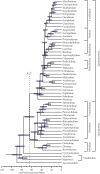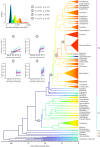Orchid phylogenomics and multiple drivers of their extraordinary diversification
- PMID: 26311671
- PMCID: PMC4571710
- DOI: 10.1098/rspb.2015.1553
Orchid phylogenomics and multiple drivers of their extraordinary diversification
Abstract
Orchids are the most diverse family of angiosperms, with over 25 000 species,more than mammals, birds and reptiles combined. Tests of hypotheses to account for such diversity have been stymied by the lack of a fully resolved broad-scale phylogeny. Here,we provide such a phylogeny, based on 75 chloroplast genes for 39 species representing all orchid subfamilies and 16 of 17 tribes, time-calibrated against 17 angiosperm fossils. Asupermatrix analysis places an additional 144 species based on three plastid genes. Orchids appear to have arisen roughly 112 million years ago (Mya); the subfamilies Orchidoideae and Epidendroideae diverged from each other at the end of the Cretaceous; and the eight tribes and three previously unplaced subtribes of the upper epidendroids diverged rapidly from each other between 37.9 and 30.8 Mya. Orchids appear to have undergone one significant acceleration of net species diversification in the orchidoids, and two accelerations and one deceleration in the upper epidendroids. Consistent with theory, such accelerations were correlated with the evolution of pollinia, the epiphytic habit, CAM photosynthesis, tropical distribution (especially in extensive cordilleras),and pollination via Lepidoptera or euglossine bees. Deceit pollination appears to have elevated the number of orchid species by one-half but not via acceleration of the rate of net diversification. The highest rate of net species diversification within the orchids (0.382 sp sp(-1) My(-1)) is 6.8 times that at the Asparagales crown.
Figures



References
-
- Chase MW, Cameron KM, Barrett RL, Freudenstein JV. 2003. DNA data and Orchidaceae systematics: a new phylogenetic classification. In Orchid conservation (eds Dixon KW, Kell SP, Barrett RL, Cribb PJ), pp. 69–89. Kota Kinabalu, Malaysia: Natural History Publications.
-
- Pridgeon AM, Cribb PJ, Chase MW, Rasmussen FN (eds). 2001–2014 Genera Orchidacearum, vol. 1–6 New York, NY: Oxford University Press.
-
- Darwin C. 1885. On the various contrivances by which orchids are fertilized by insects. London, UK: John Murray. - PubMed
Publication types
MeSH terms
LinkOut - more resources
Full Text Sources
Other Literature Sources

